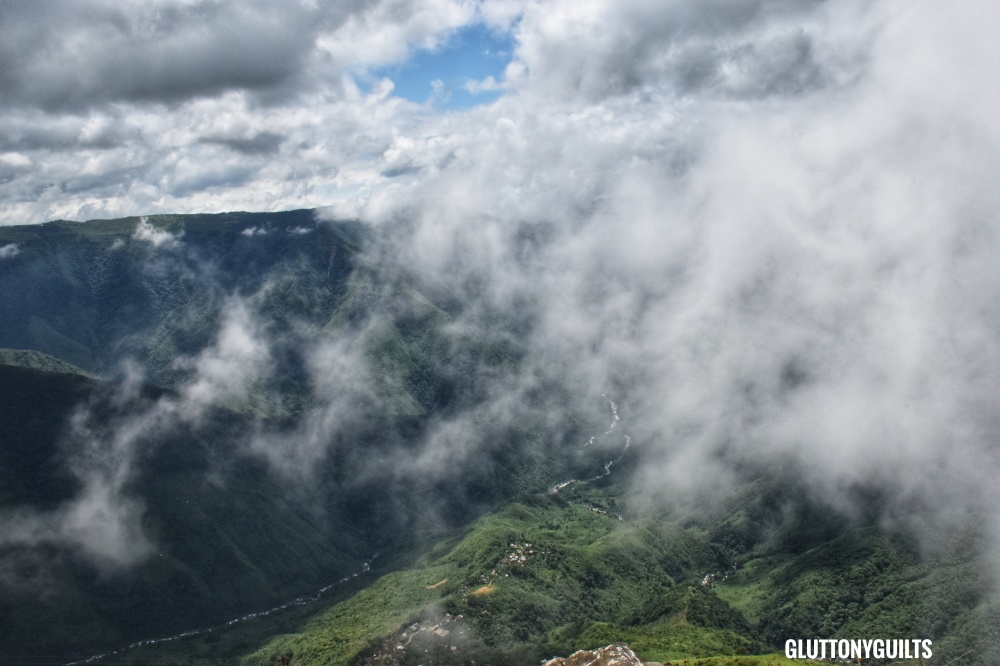We yearn for the mesmerising landscapes of Scotland and Europe which are sans the human presence and reflect the nature in its pristine glory. But do we ever wonder that similar geographical escapades are very much present in our country as well, we only have to seek them to relish them.
Time and again, I hear many travellers eloquently describing the wonders of the north eastern India. The seven sisters with a plethora of geographical spectacles have plenty of eye-soothing destinations. So when the opportunity came knocking on my door about a visit to Shillong and surrounding sights, I could not say nope, no time!
Day 1
An early morning flight to Guwahati from Delhi initiated this memorable journey. I preferred to take a power nap in the flight as the ensuing road journey to Shillong will be very tiring.

Our Air BnB owner in Shillong, Mr. Lam had sent a cab for the three of us and a local lady at the Guwahati airport ad there started our eventful road journey on NH206. The local lady, Tanya, took us to a restaurant where authentic Khasi cuisine is served. The non vegetarians amongst us had a platter of boiled sticky rice, dal, Doh-Neiong – pork cooked in a light watery gravy of tea leaves, fried chicken pakora and mutton curry. The pork was the best – mellow to the core and not the chewy variety we have in the restaurants.
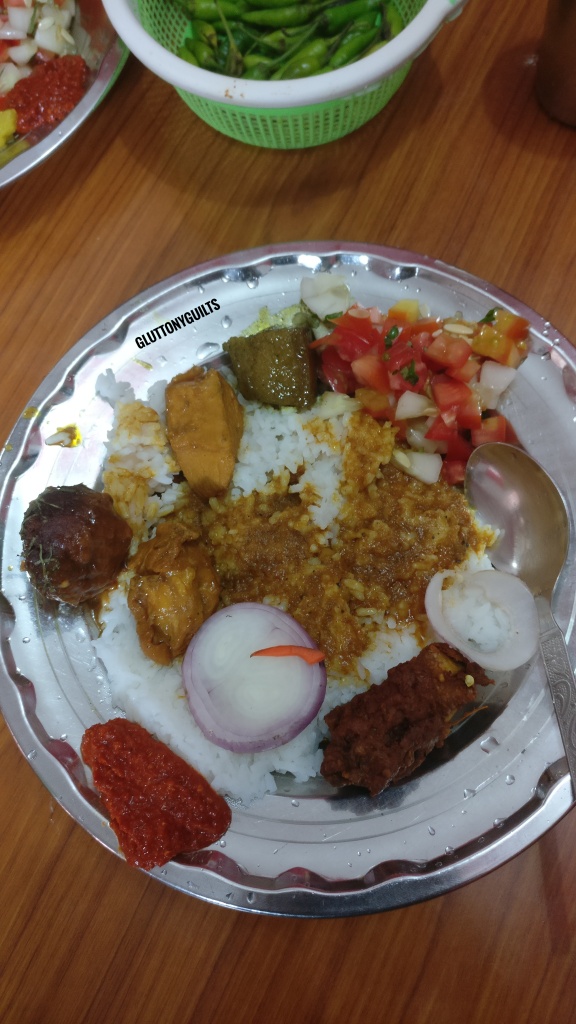
It was raining cats and dogs on the whole national highway and hence we could not savour the beauty of Umian lake or the Bada Pani.

It took us approximately four hours to reach Shillong. The traffic in Shillong is hell crazy – slower than Mumbai’s during the peak hours. We finally reached our Air BnB Thrift Inn Homestay and met our very gracious host Mr. Lam who guided us about the restaurants in the Police Bazaar.
We were assigned the apartment set on the third floor of the homestay and the view from the terrace was beautiful. The apartment is very well maintained with simplistic interiors and pamphlets posted on the walls regarding the do’s and don’t’s. There is a small living room, a lobby, two bed rooms with two beds each and cabinets, a dining area with a kitchenette and a balcony with a washroom.
We explored the area of Police Bazaar in the evening with a visit to a local fine-dine restaurant Déjà vu. The food was great there but since we longed for something north Indian, we knocked the doors of the nearby Amma restaurant and had a homely meal there.
 North Indian Thali at Amma restaurant
North Indian Thali at Amma restaurant  Diced chicken with vegetables from Deja Vu
Diced chicken with vegetables from Deja Vu  Diced chicken with vegetables from Deja Vu
Diced chicken with vegetables from Deja Vu  North Indian Thali at Amma restaurant
North Indian Thali at Amma restaurant
Day 2
The second day started early at 7 a.m. because we had to depart for Cherrapunjee to start the Living Roots Bridge trek. We were greeted with a delicious breakfast of aloo paratha prepared by Mr. Lam’s mother and we hogged onto them like voracious beasts because the coming journey and trek would rob us of calories.
Our host Mr. Lam took us on the two hour drive explaining about the weather and the surrounding landscapes. Since we were driving through the heaviest rainfall area, the visibility was low. We were practically driving through the clouds and had to be slow.
The original name for Cherrapunjee was Sohra and the locals still use this name. You can see the sign boards mentioning the name while you traverse the narrow lanes there. As Lam elaborated the history, we got to know that Cherrapunjee was the first town to be established by the Britishers in the north east India as it connected well with Bangladesh. Shillong and Guwahati were established much later. Therefore you will see some vintage Catholic churches en route to the Living Roots bridge trek.
We finally reached the place where the trek begins. The clouds had cleared by then so we started in good conditions. There are bamboo sticks available at the nearby shops with water bottles and light snacks. Washrooms are also situated there and are payable, so expect spot on cleanliness there.
There is a plethora of Living Roots Bridges in and around Cherrapunjee but the most spectacular and the oldest one is the Double Living Roots bridge which is a actually 300-400 years old. Fashioning these bridges is an art and is passed down through generations. The aerial roots of the fig trees are guided through bamboo or wood over the river streams by twisting them together time and again. Over time, more roots grow and strengthen over time. It takes about 40-50 years for a young bridge to be functional.

The trek is easier on the terrain side because you just have to climb up/down the steps. The trouble is that there are 3200 steps on one side and you first have to climb down and then up. Additionally, we are not used to climbing so many stairs, so it takes time for your body to get acclimatised. The minute you stop for rest breaks, you can feel your legs shaking because the body takes time to stop the momentum.

It is soothing to breathe the fresh air of the surrounding forest and feast your eyes with the enveloping mountains and the dispersing clouds.
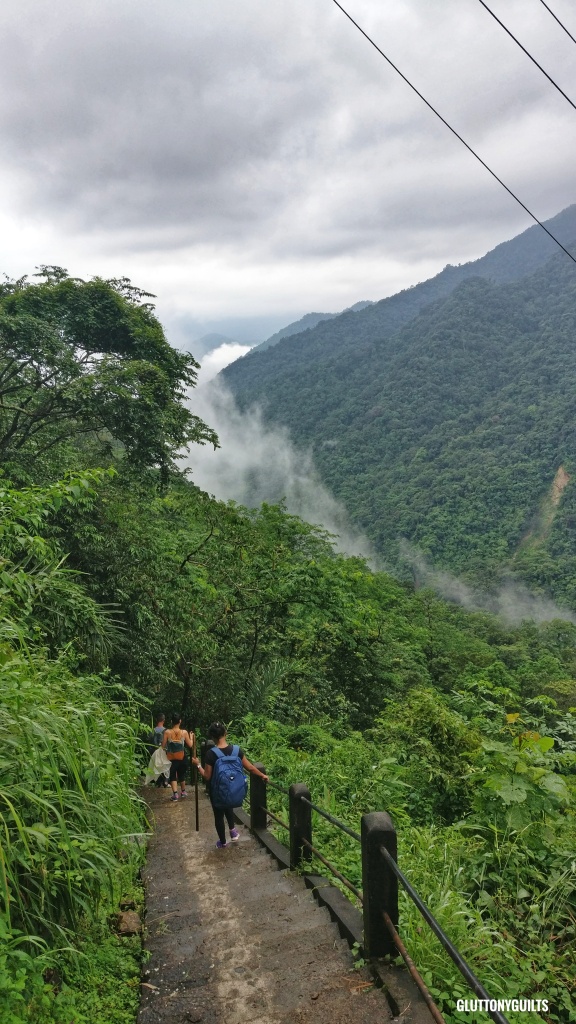
There are two suspension bridges en route to the double bridge. The first one, a steel wire suspension bridge, is darn scary because it starts oscillating if more than two people traverse on it. But the view of the river ferociously flowing over huge boulders is fearlessly enchanting.
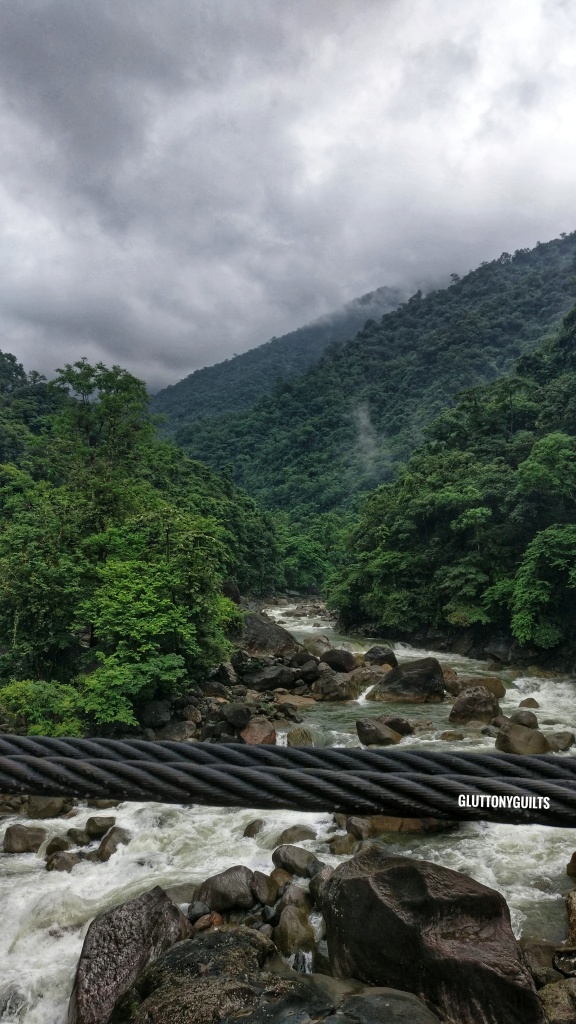
You can also spot a lot of epiphytes/fungi stuck on the trunks of dead trees.
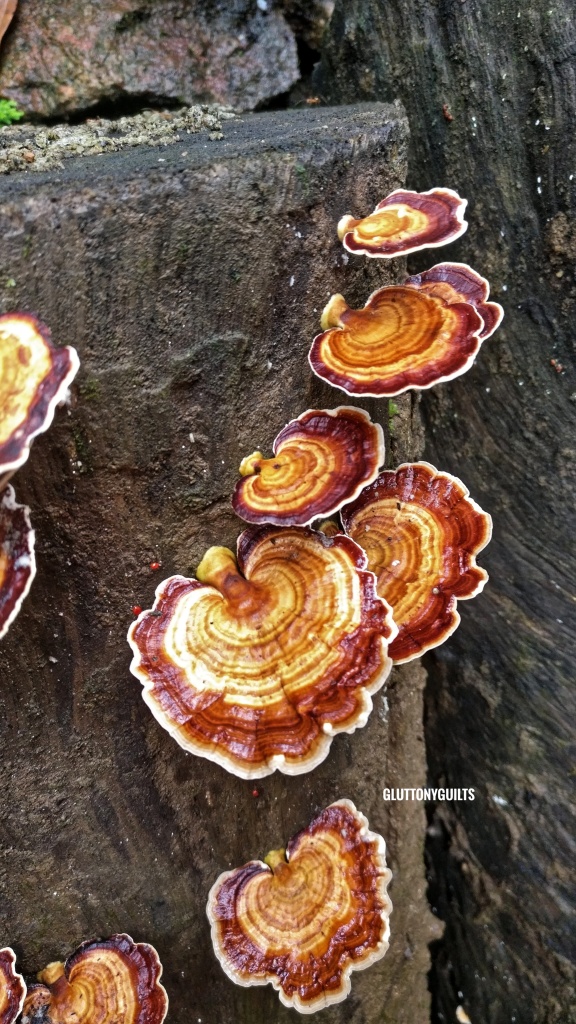
Two hours of arduous trekking finally comes to a wonderful site of the double living roots bridge and the surrounding musical waterfall. It is advisable to relax there and maybe take a dip in the clear water to soothe your tired nerves.
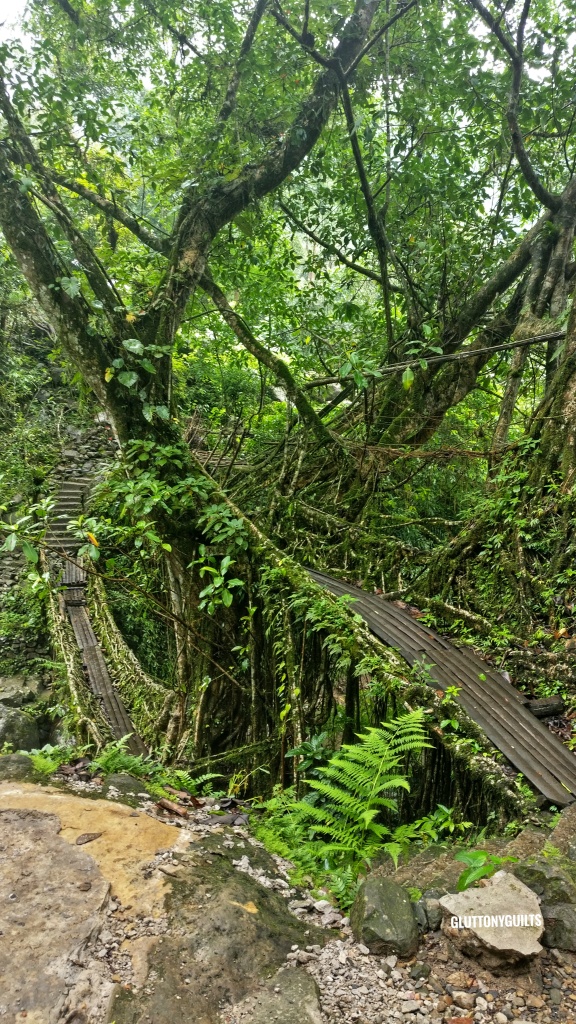
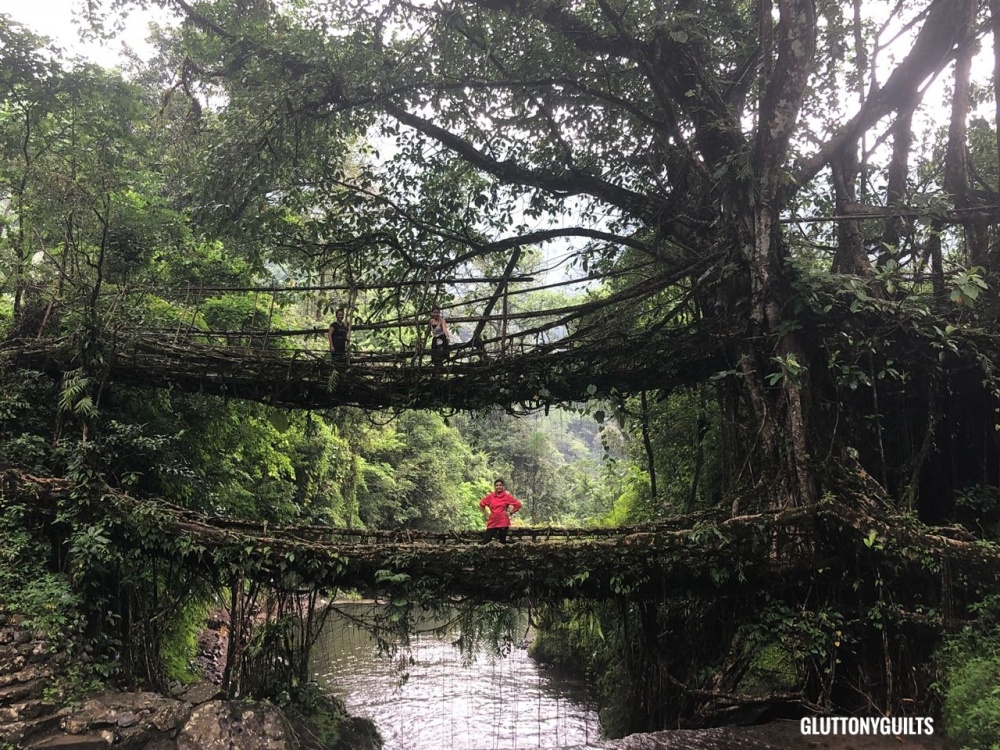
We had our lunch at a local homestay and were served the usuals – boiled rice, dal, sautéed potatoes in turmeric, egg fry and bamboo shoot pickle. The bamboo shoot pickle was lip smacking – sour with the spiciness of black pepper.
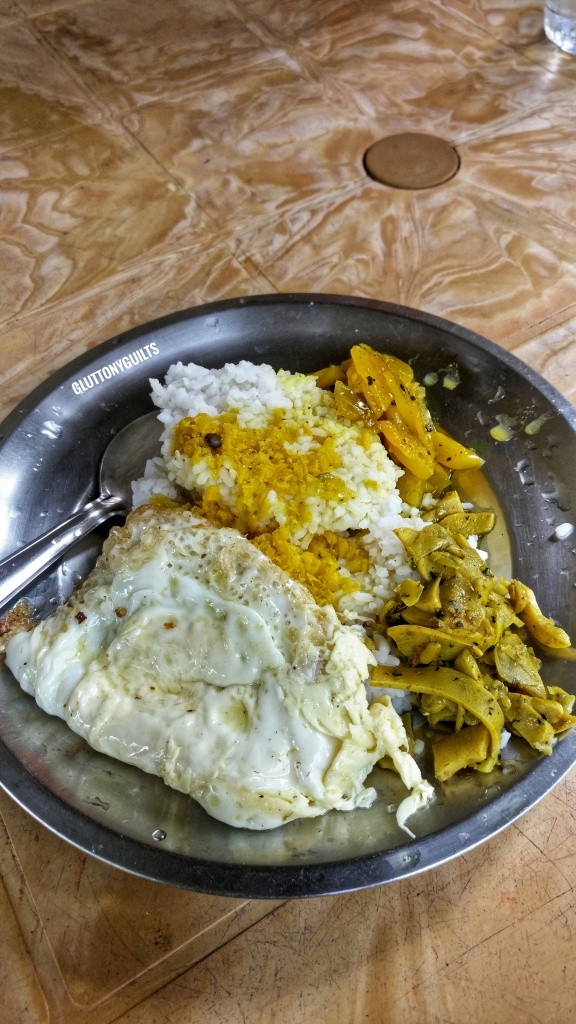
The trekking up part is really difficult because the staircase is way too steep. We were saved by the juicy pineapple available at kiosks.
The whole trek takes about five hours and is tedious. So it is better to stay at a local homestay/inn/hotel.
But as adventurous as we are and with the able guidance of our host, we decided to visit the site from where the Seven Sisters fall is visible. The clouds had finally cleared and with no sign of rainfall, our DSLR’s were out.

We had booked La Kapur Inn for our stay in Cherrapunjee and were pleasantly surprised by the helpful staff there. The owner and the one of ladies there – Teesta helped us in every way possible. The dinner was a simple affair with chappatis, dal, makhani chicken and salad.
Day 3
Lam asked us to go easy on this day as we were super tired from the trek. We started at 9 a.m. and went for a 100km drive to Dawki – the India Bangladesh border. The skies were comparatively clearer today so we could see the vibrantly green rolling hills.
We halted for a short time to buy organic black pepper, coffee and honey from a local shop and trust me, these are better than the ones you find in the super markets.
The journey is smooth but there are so many photograph spots en route that you would want to get out of your car time and again. The flowing streams, the English pines and the surrounding greenery beckons you to keep capturing them.

As soon as you enter the Dawki village, you can spot the towering betel nut trees. The surrounding flora changes to evergreen forests so expect extreme humidity which will severely drench you. If you are fond of boating, then better to board the rustic boats sailing over the muddy waters (monsoon specific) of Umngot river. Since the river was murky unlike its clear avatar, we decided to ditch boating.
Lunch was simple with the usuals and a pleasant surprise in the form of channa or back gram curry. It reminded me of my Mom’s special black gram gravy.
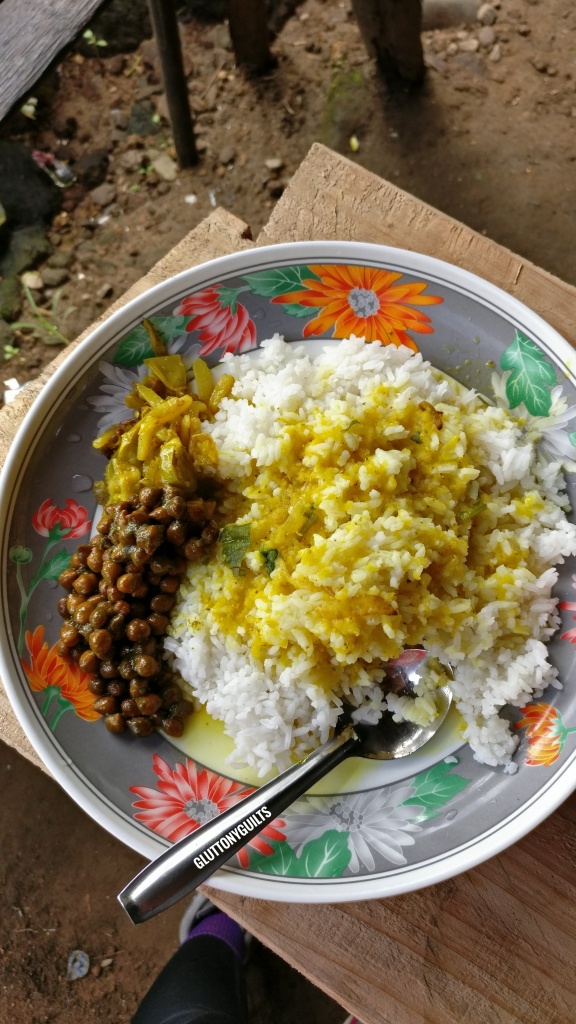
Lam had discovered a hidden falls by the name of Byrdaw near Dawki which are bewitching to say the least. There is a small 15 minutes trek to the falls through a deep forest. The melody of the falling waters can be heard from a distance and the when you actually behold the copious amounts of water falling from such a height, your heart does skip a beat.

Next up on our list was the Mawlynnong, the cleanest village in Asia. The village although clean, has been beautified with ornamental plants and creepers and does give an appearance of “made up beauty”. Nevertheless, it is a soothing place to visit after suffering the harrowing humidity of Dawki. You can also buy bamboo handicrafts from local shops here.

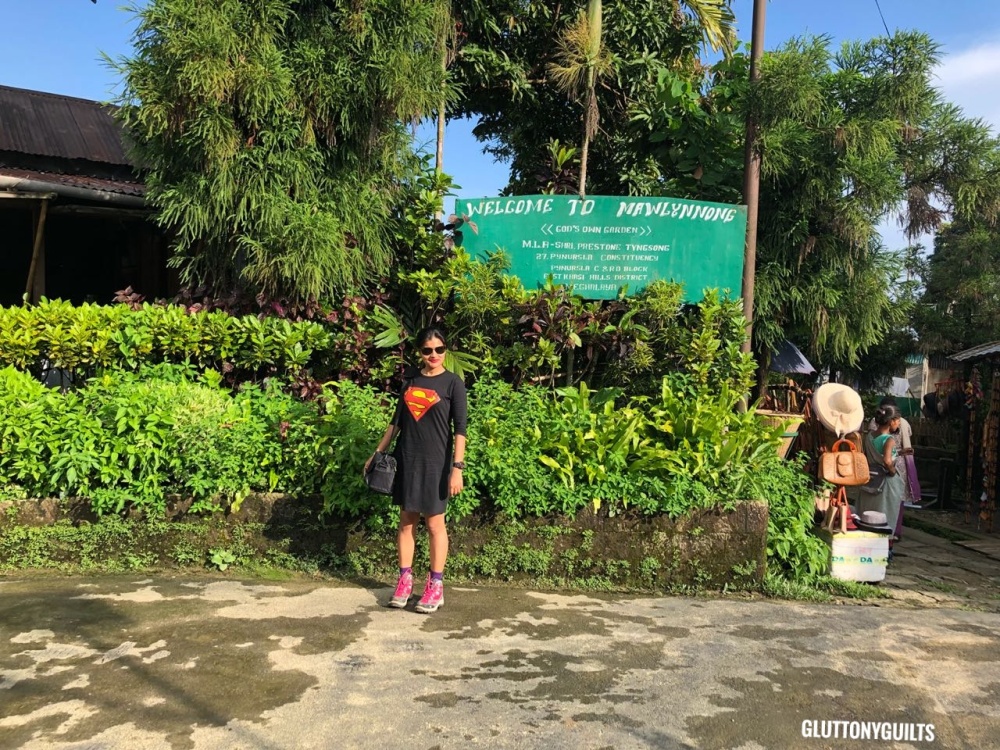
Day 3
The day started slightly late at 9:30 am as we had to roam around Shillong only. We first drove to the Laitlum village which is again surprisingly clean and eye-soothing. But the real beauty was waiting for us when we finally reached the Laitlum canyon. The moving clouds, the green hills & canyon, the wild flowers and a serpentine river make this a wonderland. People usually visit this place for old school picnics. The best part is not the natural beauty but dustbins at every few metres so that the pristine surroundings are maintained.
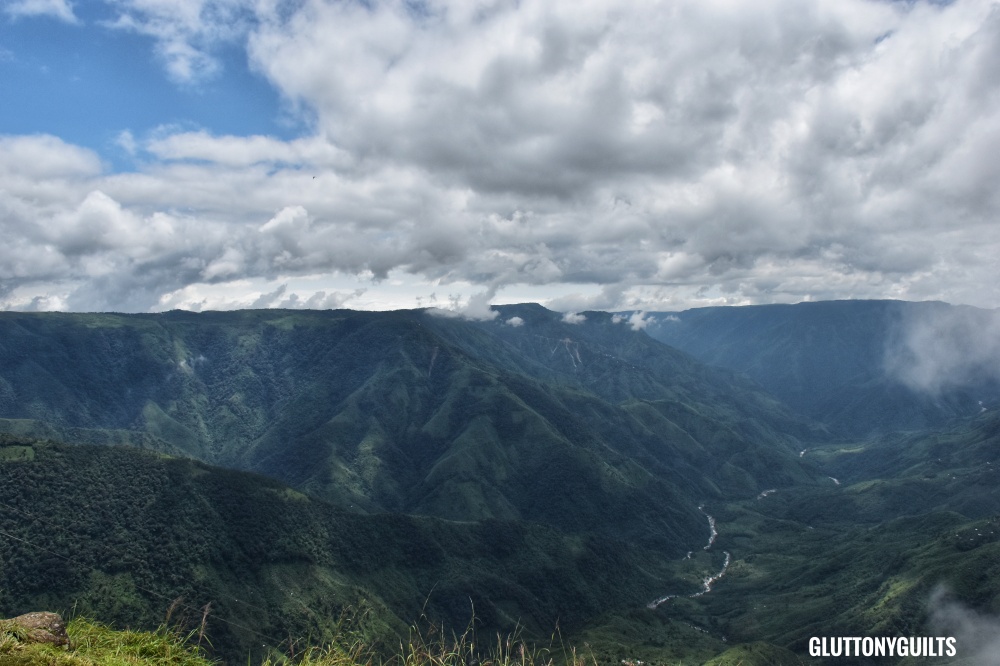

And travel to Shillong is never complete without a visit to the Maphlang sacred grove. Lam called this a magical place and it is rightly so. There are trained guides available at the entrance and the visitors have to go with them because there are certain rules to be followed while going for the scared grove walk. For instance, you can not take anything from the forest. It is believed that if you kill an organism or pluck a leaf/fruit/flower, this action will affect 1000 lives. So it is better to soak in the surroundings of the lush and dense forest and observe the flora and fauna.
There are two treks through this forest – one for half & hour and another for two hours which finishes at the famous David Scott’s trail.

Special note about our host Mr. Lam – he is extremely helpful and understanding. He took care of every aspect of the trip and even pep talked to us when we were too tired during our trek. He guided us about the spots to take photographs from and the places to visit. He also talked elaborately about the history of the places we visited and the cultural aspects present here. Here is the link to his homestay: https://www.airbnb.co.in/rooms/22151957

After the Maphlang sacred grove trek, we started for Shillong and en-route had a hearty meal at the ML05 café.
Lam arranged a cab for us for Guwahati from Police Bazaar and we reached the Assam capital by 8pm. Our stay was at an Air BnB near the Guwahati airport and it was not in the cleanest condition as the owner Mr. Tathagat was away. He eventually made up for it by dropping us at the airport in the wee hours of the morning without any charge.
Special thank you to my friends Anjali and Pratibha with whom it is always a pleasure to travel. All my pictures are clicked by Anjali through her Iphone X.


